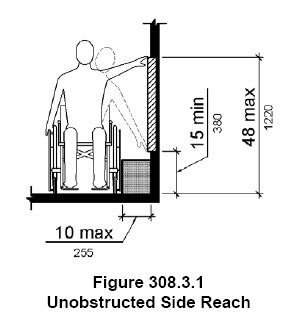I made this movie with a new website Xtra Normal. It is all about President Obama explaining the changes to the ADA and President George HW Bush reminisces about the old ADA. I hope you enjoy
Click here to view the movie
Friday, December 24, 2010
Thursday, December 9, 2010
How do we deal with access into small closets?
shelving to the back to make the space less than 48" and therefore does not allow
for full entry.
Deep Closet and no turning space
If you have a closet that is narrow , like 36" wide, but deeper than 48", and already has shelving in the back, one solution is to swing the door in so that there is no risk in getting trapped inside by the door closing and not being able to turn around to exit after the door is closed.


Deep closet with in swinging door
Inspector's Corner: Shallow Closet
The 2010 Standards for Accessible Design, states the requirements for storage in
section 811, but it refers you back to section 308 for reach ranges. If you have
a shallow closet, there needs to be a reach range per Figure 308.3.1 which shows
an unobstructed side approach. The only obstruction you can have 10" of depth
maximum. The rod or shelving would have to be no taller than 48" high

In this shallow closet used to hang smocks and personal belongings at a beauty salon ,
the doorway is not 30" therefore a side approach is required. But the rod is higher than
48" and the distance away from the doorway was more than 10". Therefore this was not
an acceptable storage closet.

A solution could be to add a second rod that is at 48" high and 10" away from the
opening of the storage closet.
Subscribe to:
Comments (Atom)








